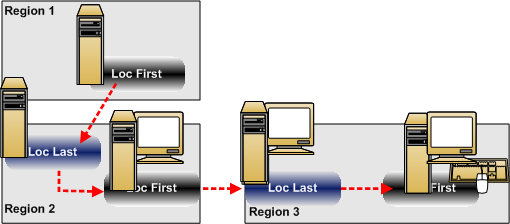Range Source Architecture (RSA) complements and works alongside the traditional RCO decision-elimination logic.
|
Traditional Routing Logic. |
|
|
Range Source Architecture. |
Traditional Routing Logic
Items are evaluated when they are located in a first or last location in a source region.
The Routing Logic, follows a definite sequence.
Example
The assembly floor of a computer manufacturer has three regions.
Computers travel from the first location in one region to the last location in the next.
They are assembled sequentially in each region as they travel from last to first place.

Range Source Architecture
Range Source Architecture enables decisions to be made for items in any location in as many regions as you want.
This architecture is designed for items that do not require linear movement such as orders or items stored in an automated system retrieval system (ASRS) in which items can be randomly selected. The actual location is immaterial.
The initially intended purpose of a range is to evaluate, select, sequence, substitute, hold or eliminate items to be produced by evaluating the purchase orders.
Since orders can be grouped into pre-defined categories (virtual regions), not physical locations, the criteria for selecting the range to be evaluated is limited only by what you specify. There are no outside constraints.
Ranges simply take advantage of this non-restrictive capability.
A range can be:
![]() A single region.
A single region.
![]() Several regions from one or more
projects.
Several regions from one or more
projects.
![]() A subset of sequential locations
from one or more regions, in one or more projects.
A subset of sequential locations
from one or more regions, in one or more projects.
![]() A query that returns, on-the-fly,
any combination of regions and/or region locations.
A query that returns, on-the-fly,
any combination of regions and/or region locations.
![]() Note: The TBNG_POMS
template enables you to create a project with pre-defined regions
that can be used exactly how they are configured or modified to
your system's needs.
Note: The TBNG_POMS
template enables you to create a project with pre-defined regions
that can be used exactly how they are configured or modified to
your system's needs.
Example
The computer factory evaluates purchase orders to manage if, when and in what sequence manufacturing will fulfill the order.
![]() The range in which evaluation will
take place includes all location in the $OM_MASTR_BLND region.
The range in which evaluation will
take place includes all location in the $OM_MASTR_BLND region.
![]() $OM_MASTR_BLND contains orders
that were accepted for production.
$OM_MASTR_BLND contains orders
that were accepted for production.
![]() The goal is to select the next
order to move to the $OM_PLANT_BLD region.
The goal is to select the next
order to move to the $OM_PLANT_BLD region.
This can be accomplished in the range as RSA:
Evaluates the orders using a combination of business rules.
Eliminates order that fail.
Selects the single remaining order as the next item to process.
Moves the selected order to $OM_PLANT_BLD.
![]() The order can be any one in the
range. Its location is irrelevant.
The order can be any one in the
range. Its location is irrelevant.
Note: The colors of the orders in this graphic represent the color of the computer that is being ordered.

L1, L2...L20 = Locations
P01,P02...P20 = Purchase orders
|
RSA modules. |